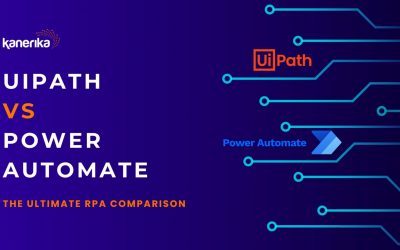In the fast-paced world of business and technology, automation tools have become indispensable. These tools allow for the streamlining of workflows, the scaling of operations, and the freeing of valuable human resources for more complex tasks. The question, however, is which process automation tool is right for your organization? In this comprehensive article, we delve into a detailed comparison of several leading automation platforms: UiPath, Microsoft Power Automate, Azure Logic Apps, Power Apps, and Zapier.
UiPath vs. Microsoft Power Automate
UiPath
1. Scope
UiPath is fundamentally designed for Robotic Process Automation (RPA). The platform is geared towards automating complex tasks involving various desktop and web applications, including data entry, file transfers, and even machine learning tasks. Businesses in healthcare, finance, and manufacturing have successfully employed UiPath to automate multi-step, rule-based tasks.
2. Ease of Use
UiPath is a developer-centric process automation platform, requiring users to have a reasonable understanding of programming concepts. However, it offers a comprehensive set of learning resources, including UiPath Academy, which has courses for different levels.
3. Scalability
UiPath can manage multiple robots, and it allows for cloud-based or on-premises deployment. With the use of Orchestrator, a web-based application, businesses can deploy, schedule, and monitor automated tasks on a large scale.
4. Pricing
The pricing structure is on the expensive side, making UiPath a less viable option for small businesses or individual users. Enterprise-level agreements and licenses are usually negotiated on a case-by-case basis.
5. Integrations
The platform has wide-ranging integrations, not just confined to ERP systems like SAP, but also extends to databases, email services, and various other software applications. You can find more in our case study here.
Microsoft Power Automate
1. Scope
Microsoft Power Automate, formerly known as Microsoft Flow, is a cloud-based software tool that allows employees to create and automate workflows and tasks across multiple applications and services without needing developer help. These can range from simple tasks such as notifications to complex operations involving multiple steps and conditions.
2. Ease of Use
With a user-friendly, drag-and-drop interface, Power Automate is accessible even for those who don’t have a coding background. This makes it a go-to for businesses looking for quick automation solutions that any team member can manage.
3. Scalability
While Microsoft Power Automate is scalable, it may not handle complex, multi-step tasks as seamlessly as UiPath. However, its cloud-based nature ensures relatively simple scaling options, making it suitable for medium-sized businesses.
4. Pricing
The pricing model is more flexible than UiPath, providing various plans, including a free tier. The pay-as-you-go model can be advantageous for businesses just starting with automation.
5. Integrations
Power Automate is robust in its integrations but has a noticeable bias towards Microsoft-based services like SharePoint, Dynamics 365, and Office 365. It can connect with various other services through connectors, but the scope is more limited compared to UiPath.
Also Read- Microsoft Power Automate – Does your business need it?
Key Takeaway
Choose UiPath if your organization requires complex, rule-based tasks, significant scalability and you have the technical expertise to manage it. Microsoft Power Automate, on the other hand, is a better fit for general process automation that can be easily managed by individuals with limited technical skills, especially if your organization is already using Microsoft services extensively.
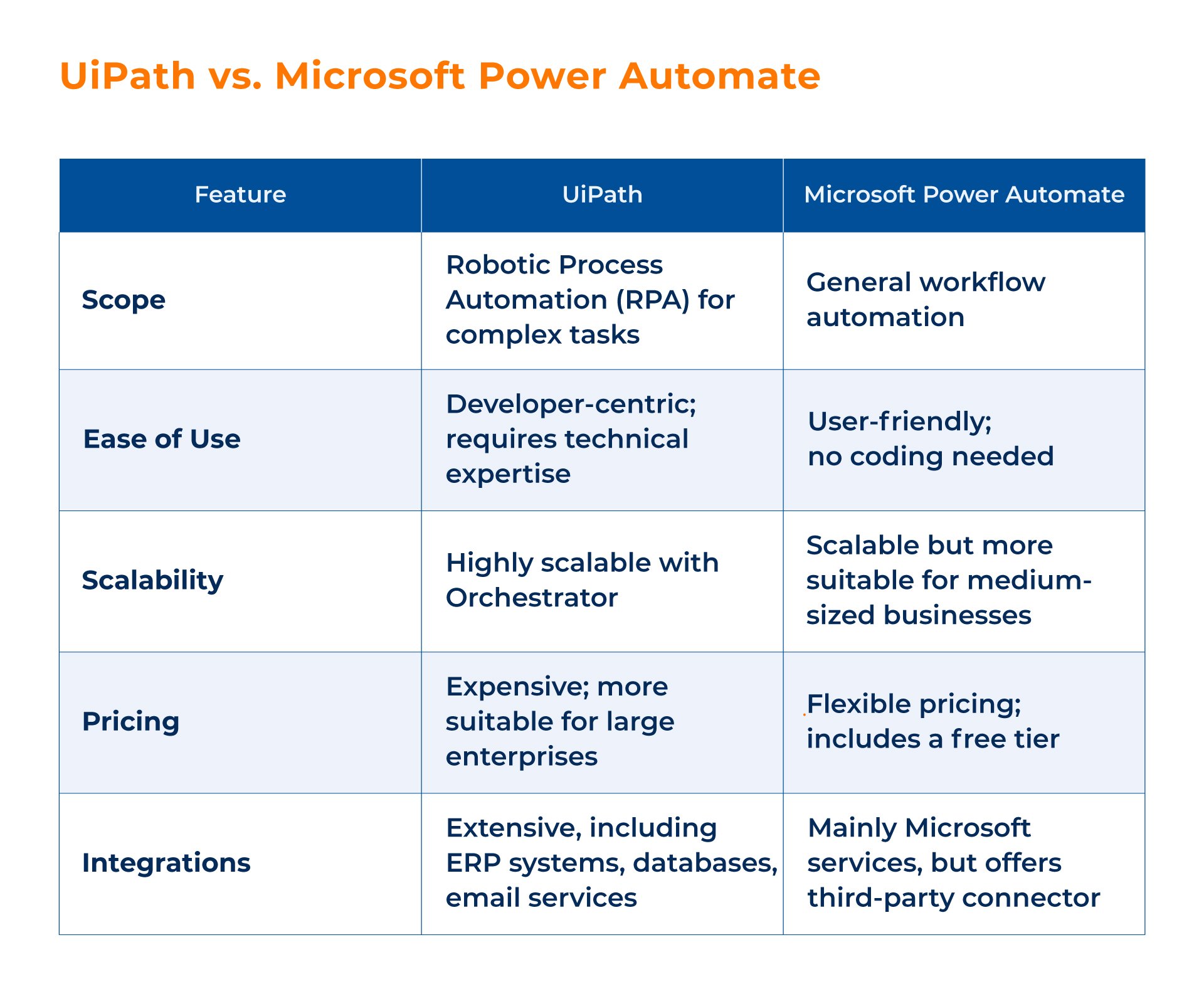
Azure Logic Apps vs. Power Automate
Azure Logic Apps
1. Scope
Azure Logic Apps is tailored for IT professionals and developers and provides a way to automate, orchestrate, and integrate different services, both within Microsoft’s sphere and outside it. For example, you could automate the processing and routing of orders across an eCommerce platform, a payment gateway, and an inventory management system.
2. Ease of Use
The tool requires a deep understanding of logical structures and a certain level of coding, making it less user-friendly for non-tech-savvy individuals. However, for those familiar with Azure services, it offers deep customization capabilities.
3. Scalability
With the backing of Azure cloud services, Logic Apps is extremely scalable, capable of handling large volumes of transactions and complex workflows. It can be as simple as sending a response to an HTTP request, or as complex as coordinating actions across a range of cloud and on-premises services.
4. Pricing
Pricing for Azure Logic Apps is based on a consumption model, calculated based on the number of runs, triggers, and actions. For large enterprises, the cost can add up, but it provides a lot of power in return.
5. Integrations
Azure Logic Apps offers extensive integration capabilities. Because it’s part of the larger Azure ecosystem, it integrates seamlessly with other Azure services. However, Logic Apps also offers connectors for numerous third-party services and databases.
Microsoft Power Automate
1. Scope and Ease of Use
Power Automate is designed more for the everyday user, simplifying task automation across various services and applications. With its drag-and-drop interface and a plethora of templates, it’s easy for users to set up their own flows without delving into code.
2. Scalability
While Power Automate is scalable, especially for medium-sized businesses, it’s not as robust as Azure Logic Apps for handling complex, multi-faceted tasks across multiple services and databases.
3. Pricing
Power Automate offers a variety of pricing models that cater to different business sizes and requirements, generally making it more budget-friendly than Logic Apps for smaller tasks and organizations.
4. Integrations
Power Automate focuses on the seamless integration of Microsoft-based services but does offer a reasonable number of connectors for third-party services, albeit not as many as Azure Logic Apps.
Key Takeaway
If you’re an IT professional looking for a tool that offers extensive customization and scalability, Azure Logic Apps is your best bet. For simpler tasks that can be managed by a broader range of team members, Power Automate is the more approachable choice.

Power Apps vs. Power Automate
Power Apps
1. Scope
Power Apps is a suite of apps, services, connectors, and a data platform that provides a rapid application development environment to build custom apps for your business needs. It is particularly useful for creating mobile- and web-based applications that handle processes, such as order management, inventory tracking, and customer service.
2. Ease of Use
Power Apps employs a low-code development environment, allowing users with minimal coding experience to create apps. With drag-and-drop functionality and templates, it’s relatively easy to build an application from scratch.
3. Scalability
While Power Apps is useful for creating applications that solve specific problems, it is not necessarily designed for automating workflows or complex tasks that span multiple applications and services.
4. Pricing
Power Apps has a flexible pricing model, offering both per-user and per-app plans, which can be more budget-friendly for smaller teams or projects with limited scope.
5. Integrations
Power Apps integrates mainly with Microsoft-based services but offers a fair number of connectors to third-party applications and databases.
Power Automate
1. Scope and Ease of Use
As described before, Power Automate is tailored for automating workflows and tasks across various services and applications. It’s easier to set up compared to Power Apps if your main objective is automation rather than application development.
2. Scalability
Power Automate is highly scalable within the context of workflow automation but doesn’t have the application development capabilities that Power Apps provides.
3. Pricing
Similar to Power Apps, Power Automate provides a variety of pricing plans, including a free tier.
4. Integrations
While Power Automate is also mainly integrated with Microsoft services, it offers connectors to a broader range of third-party services compared to Power Apps.
Key Takeaway
If your primary need is creating applications that solve specific business problems, then Power Apps should be your go-to process automation tool. For automating tasks and workflows across multiple services, Power Automate is the more appropriate choice.
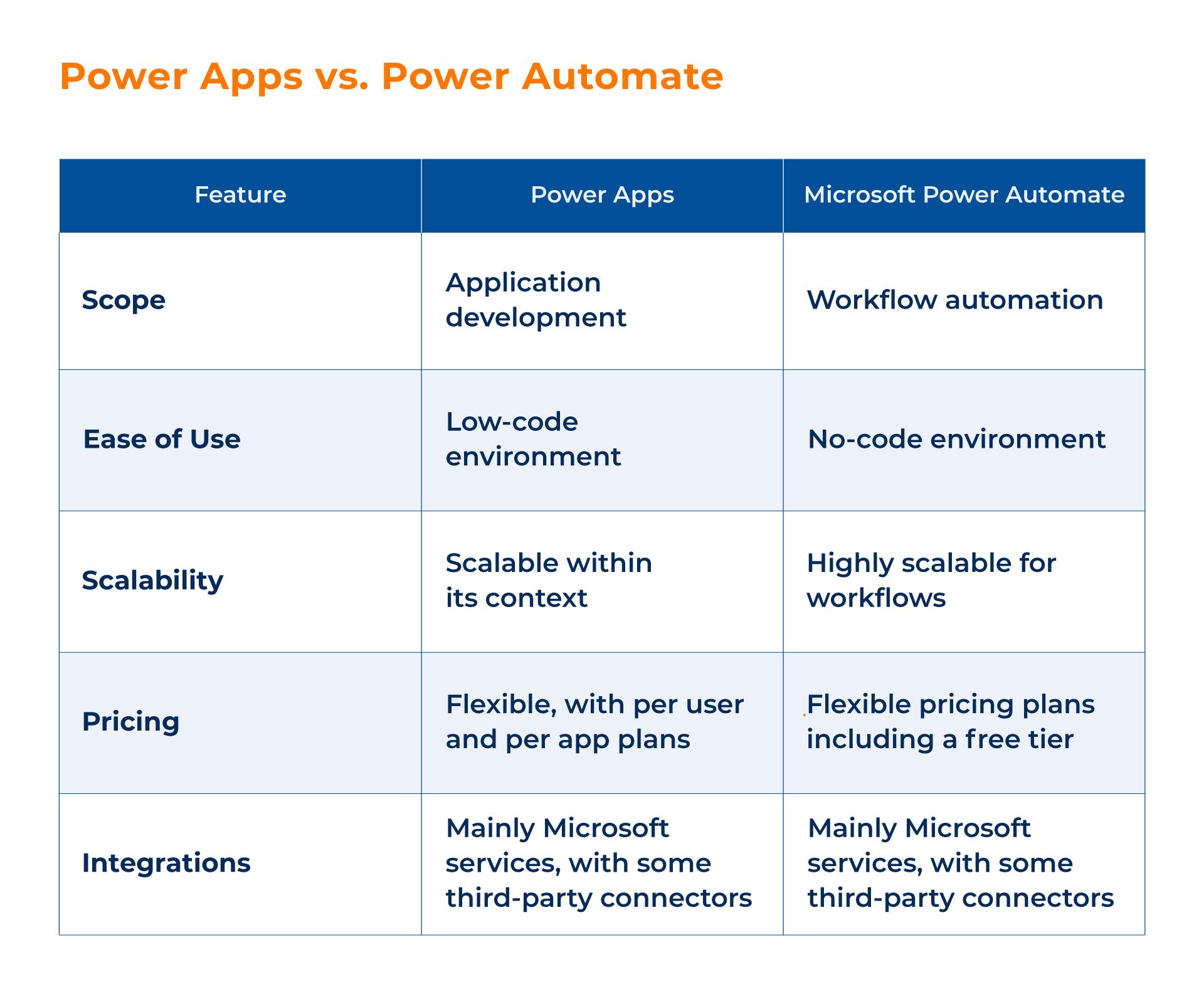
Zapier vs. Microsoft Power Automate
Zapier
1. Scope
Zapier focuses exclusively on task automation between different web apps. It is designed to be a glue that connects different services together, facilitating the exchange of information and the automation of tasks.
2. Ease of Use
Zapier is incredibly user-friendly, allowing users to create “Zaps” through an intuitive, step-by-step process that doesn’t require any coding.
3. Scalability
Although Zapier can handle high-volume data transfers, it might not be as robust as Power Automate in terms of complex workflows that involve conditional logic and multiple steps.
4. Pricing
Zapier has a freemium model with additional features available in premium plans. The pricing scales with the number of tasks you need automated and the complexity of the workflows.
5. Integrations
Zapier has one of the largest libraries of app integrations, making it a versatile process automation tool. It is ideal for connecting a multitude of services that may not natively communicate with each other.
Microsoft Power Automate
1. Scope and Ease of Use
Power Automate excels in automating workflows, particularly within the Microsoft ecosystem. It also has a more extensive feature set for complex workflows, involving conditionals and loops.
2. Scalability
Power Automate is a scalable process automation tool but leans towards favoring Microsoft-based services.
3. Pricing
Although Power Automate and Zapier have somewhat comparable pricing, Power Automate offers bundled packages with other Microsoft services, which can be cost-effective for businesses already invested in the Microsoft ecosystem.
4. Integrations
Power Automate has a strong set of connectors but is somewhat limited when compared to the extensive library that Zapier offers for non-Microsoft services.
Key Takeaway
Zapier is an excellent choice for straightforward task automation that requires integrating a wide variety of web apps. Power Automate, meanwhile, is more suited for more complex workflows, particularly if you’re already using Microsoft services.
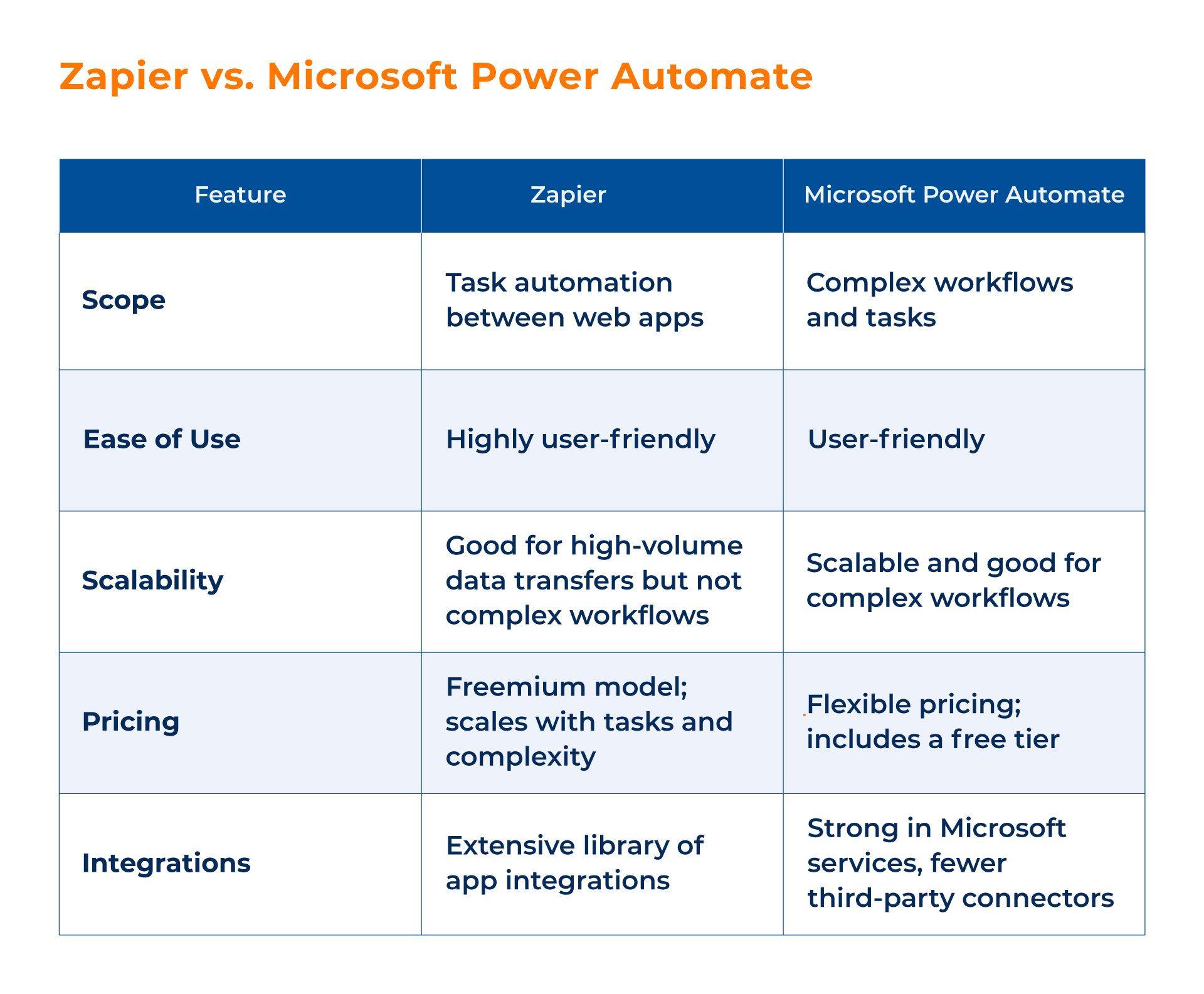
Summary
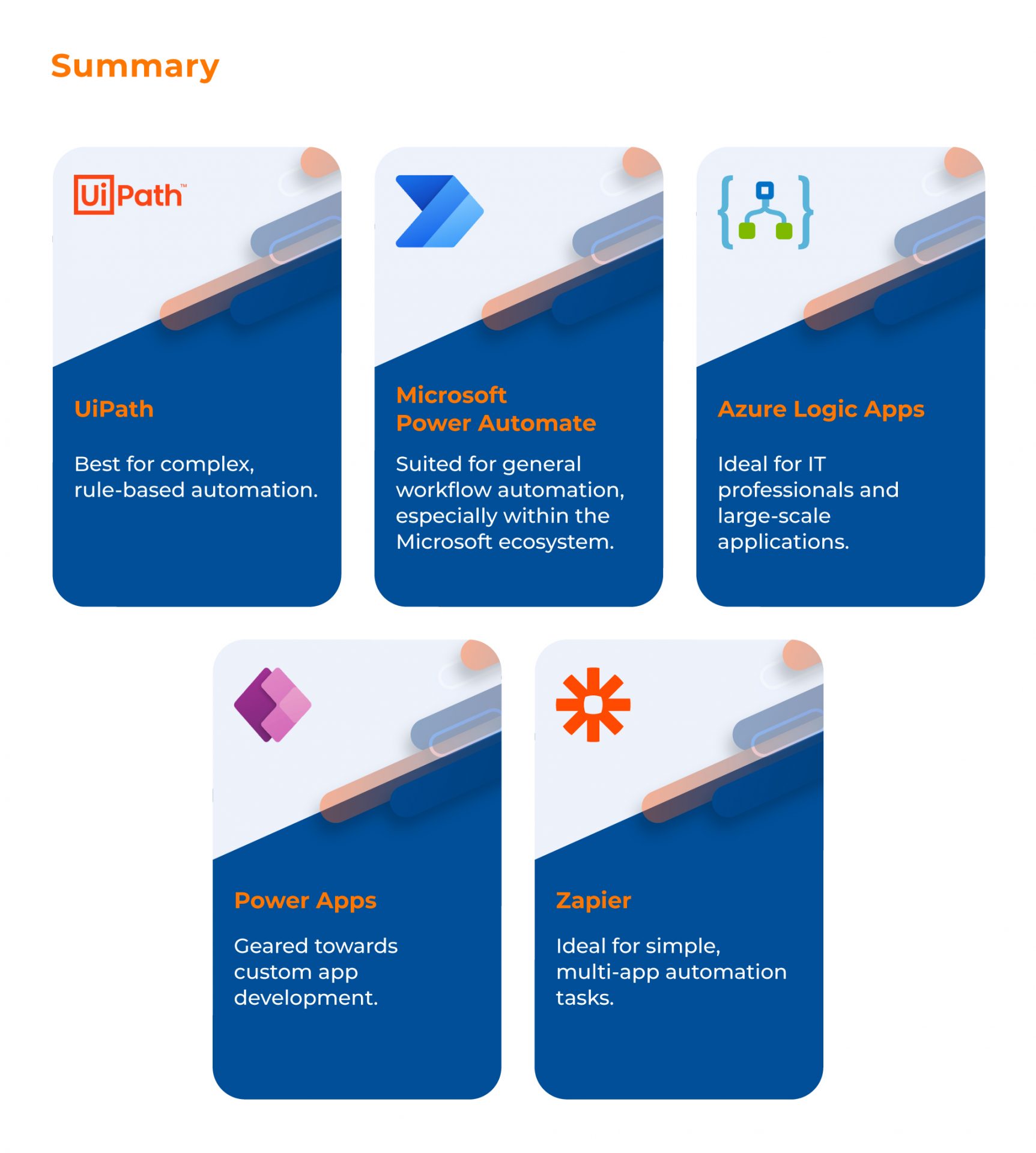
Does your Business Need Automation?
The best process automation tools for your organization will depend on a variety of factors including the complexity of the tasks you need to automate, the scalability requirements, and the existing systems in place. Each platform has its unique strengths and weaknesses, but understanding these can help you make an informed decision.

Next Steps: Learn about…
FAQs
What are the core functionalities of each automation tool?
Can these tools scale with my business?
What are the pricing models for Microsoft Power Automate, UiPath, Azure Logic Apps, Power Apps, and Zapier?
How secure are Microsoft Power Automate, UiPath, Azure Logic Apps, Power Apps, and Zapier?
What kind of customer support is available for Microsoft Power Automate, UiPath, Azure Logic Apps, Power Apps, and Zapier?
Which tool is best suited for data analytics automation?
How do these automation tools perform in terms of reliability and uptime?
How do these automation tools integrate with CRM systems, and what are the benefits?
- Microsoft Power Automate: Can seamlessly integrate with Microsoft Dynamics 365 and enables automation of lead scoring, data entry, and report generation.
- UiPath: Facilitates the automation of tasks within CRM systems like Salesforce, such as automated data scraping and customer history analysis.
- Azure Logic Apps: Offers native connectors for various CRM tools like Salesforce and enables event-triggered actions.
- Power Apps: Custom apps can be built to work hand-in-hand with your CRM, allowing for tailored solutions.
- Zapier: Pre-built “Zaps” are available to connect popular CRMs like HubSpot, automating workflows like lead capture and email marketing.


